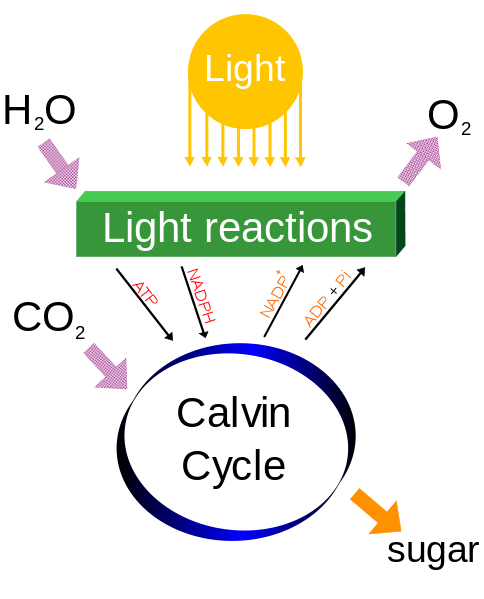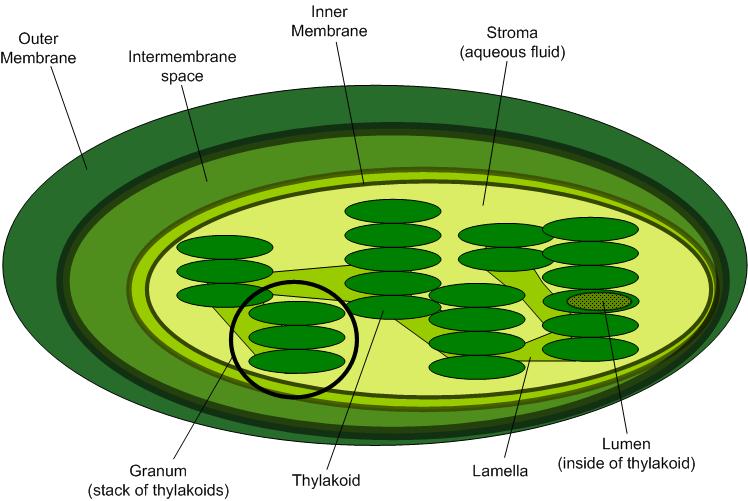
Nutrition
All organisms must have some system of obtaining energy to perform their functions, whatever they may be. The way of obtaining this energy is called nutrition. Among all organisms, nutrition is a incredibly varied process.
Organisms that make their own food are given the title of autotrophic. Let's dissect this using Latin, auto- means self and -trophic means feeding, which accurately explains how Convallaria majalis, and most other plants for that matter, get their energy. Autotrophic plants are also considered primary producers, since they use inorganic materials to create organic ones.
The process by which these organic molecules are created in autotrophs is called photosynthesis. Your biggest questions about photosynthesis are about to be answered, so get ready! Photosynthesis can be summarized in a chemical equation; an equation that stands for a complex series of reactions. The photosynthesis equation is below.

Zoofari, Wikimedia
Commons, 2010.
WHAT?
As seen above, there are a few things that must be present for
photosynthesis to occur. First off is carbon dioxide, which will
help give us the organic component of the organic compound (sugar).
This carbon dioxide comes from the atmosphere. Water will be the
electron donor in this entire process, which I will outline in
further detail down this page. It is important to note
that this water usually comes from the roots, where it was absorbed
from the soil, with the help of some special
interactions found in the roots. The
electron donated by water will be excited by light, usually
sunlight. With these three things present, the photosynthetic
organism will go through two separate processes to create sugar, the
organic compound necessary to harvest energy. Oxygen is created as a
waste product of the plant, it is the result of the split water
molecule.
 WHY?
WHY?
It is important to remember the place of photosynthesis in the large
scheme of things. The purpose of the entire process is to create
energy to power the cells of the plant. To the left is a diagram of
the general overview of photosynthesis. Although it seems complex,
once we break the process down, it will be much more understandable,
I promise! First off note that photosynthesis is broken down into
two major steps: the Light Reactions and the Calvin Cycle. Both of
these cycles are incredibly important in the creation of sugars for
the plant, and they are discussed in greater detail below. It is
important to realize that through out the process, ATP and NADPH are
regenerated. Both of these molecules are able to carry a lot of
energy in their many bonds, and that is what makes them so useful in
this process. Energy must be invested to create the bonds, but
energy is released when the bonds are broken.
Daniel Mayer, Wikimedia Commons, 2008.
 WHERE?
WHERE?
The entire process about to be outlined is happening in
the chloroplast of a leaf cell within Convallaria majalis
in a matter of seconds. The chloroplast is a specialized organelle
within in the plant. Other plant organelles serve as excellent
adaptations as well. The chloroplast
gives the plant its green color and is usually the easiest structure
to identify when looking at plant cells under a microscope. Notice
the diagram on the right, it labels the parts of the chloroplast,
but we are most concerned with the
thylakoid and the stroma. The
thylakoid
It'sJustMe, Wikimedia Commons, 2005.
is a series of folded membranes, and some of
photosynthesis actually happens in this membrane. The thylakoid
membrane has special pigments, or molecules that reflect certain
frequencies of light, embedded in it, called chlorophyll. The stroma
is the fluid that fills the chloroplast. The other half of
photosynthesis will actually happen within this fluid. With these
things located and defined, let's break this process down even more.
Warning: If these explanations don't make much sense to you, don't stop reading! Check out the video links for a visual representation.
HOW?
Photosynthesis is broken down into two different
steps. Each of the steps serves a different purpose within the
entire photosynthetic cycle.
The Light Reactions
The first part of photosynthesis requires capturing the
energy of the light, hence the name the Light Reactions. This part
of photosynthesis will be occurring within the thylakoid membrane.
The light reactions revolve around changing light energy into
chemical energy, or energy stored in chemical bonds. These chemical
bonds must have energy invested and stored into them in the Light
Reactions. This energy will later be used in the Calvin Cycle. NADP+
and ADP are the means by which this chemical energy will travel.
The Light Reactions begin with water being split into O2,
which will eventually be released via special
adaptations within the leaf, H+
and an electron. This electron will enter an excited state with the
help of light and the chlorophyll molecules. The electron will move
through two different groupings of chlorophyll called photosystems.
After this, the electron will eventually bond to NADP+
and create NADPH, an energy rich molecule that will be used in the
Calvin Cycle.
Now the H+ that was split from the water, will be used to help make
the ADP into ATP.
The Calvin Cycle
The Calvin Cycle, sometimes called the Dark Reactions follows the Light Reactions in the plant.
This series of reactions will occur within the stroma, or the fluid
within the chloroplast. The Calvin Cycle will utilize the NADPH and
ATP made in the light reactions to power through a series of
reactions to turn atmospheric and inorganic CO2 into C6H12O6,
or sucrose, a useable plant sugar. An enzyme, or a specialized group
of proteins that help a reaction occur, is necessary to start of the
cycle. RuBisCo is this enzyme. RuBisCo will take the CO2 and take it
through a series of reactions in order to turn it into the useable
form of energy. ATP and NADPH will be used in these enzymes to
provide energy. When the energy is harvested from the bonds in these
molecules, they will return to their less energetic forms, ADP and
NADP+. Both will return to the thylakoid membrane in
order to regain these bonds, so they can be recycled for continual
reuse. The most important result of the Calvin Cycle is the creation
of sucrose, C6H12O6, the most
useable, transportable and arguably important compound found within
plants.
So there you have it, you have just created plant energy! Take your time exploring the complexities of photosynthesis with this interactive and detailed model of what goes on in each step. This video goes in depth into the reactions that take place, but is an excellent visual representation of what is happening during photosynthesis. To find out how these sugars, as well as water are transported within the plant, check out water and sugar movement on the adaptations page.
The plant uses this sugar for energy and growth. Continue on to Convallaria majalis life cycle page to learn how this plant uses this energy.